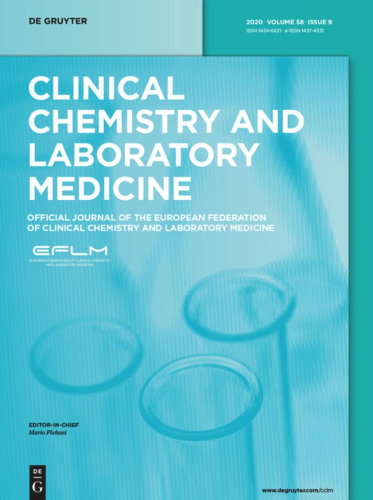评估筛查ε2ε2 和罕见 APOE 变体携带者脂蛋白血症的生化算法
IF 3.8
2区 医学
Q1 MEDICAL LABORATORY TECHNOLOGY
引用次数: 0
摘要
目的 白细胞脂蛋白异常血症(DBL)是一种与动脉粥样硬化性心血管疾病风险增加有关的合并血脂异常,主要发生在ε2ε2受试者中,在具有罕见APOE变异的受试者中并不常见。目前已提出了几种筛选 DBL 的算法。在这项工作中,我们比较了包括一种新算法在内的九种算法的诊断性能。方法 根据 APOE 基因型将患者分为三组:ε2ε2("ε2ε2",n=49)、罕见变体携带者("APOEmut",n=20)和非ε2ε2 或 APOE 罕见变体携带者("对照组",n=115)。比较的算法包括 Fredrickson、Sniderman、Boot、Paquette、De Graaf、Sampson、eSampson、Bea 和我们的 "Hospices Civils de Lyon (HCL) 算法"。我们的金标准是存在ε2ε2基因型或与甘油三酯(TG)>1.7 mmol/L相关的罕见变体。仅考虑甘油三酯和低密度脂蛋白胆固醇(LDLc)均为第 90 百分位数的受试者,在英国生物库中进行了复制,并进行了稳健性分析。结果 总胆固醇 (TC)/ApoB 和 NHDLC/ApoB 是怀疑 DBL 的最佳比率。在ε2ε2中,根据似然比(LR),临床上最有效的算法是HCL、Sniderman和De Graaf算法。在 APOEmut 中,Sniderman 算法的阴性似然比最低(0.07),而 HCL 算法的阳性似然比最高(29)。在两个队列中,HCL 算法的 LR 都是最好的。结论 我们提出了一种基于载脂蛋白 B 浓度和常规血脂谱的强大算法,该算法在检测ε2ε2 或 APOE 变异相关 DBL 方面表现出色。还需要进行更多的研究来进一步评估算法在不常见的 APOE 变异 DBL 携带者中的表现。本文章由计算机程序翻译,如有差异,请以英文原文为准。
Evaluation of biochemical algorithms to screen dysbetalipoproteinemia in ε2ε2 and rare APOE variants carriers
Objectives Dysbetalipoproteinemia (DBL) is a combined dyslipidemia associated with an increased risk of atherosclerotic cardiovascular diseases mostly occurring in ε2ε2 subjects and infrequently in subjects with rare APOE variants. Several algorithms have been proposed to screen DBL. In this work, we compared the diagnostic performances of nine algorithms including a new one. Methods Patients were divided into 3 groups according to their APOE genotype: ε2ε2 (“ε2ε2”, n=49), carriers of rare variants (“APOEmut”, n=20) and non-carriers of ε2ε2 nor APOE rare variant (“controls”, n=115). The algorithms compared were those from Fredrickson, Sniderman, Boot, Paquette, De Graaf, Sampson, eSampson, Bea and ours, the “Hospices Civils de Lyon (HCL) algorithm”. Our gold standard was the presence of a ε2ε2 genotype or of a rare variant associated with triglycerides (TG) >1.7 mmol/L. A replication in the UK Biobank and a robustness analysis were performed by considering only subjects with both TG and low-density lipoprotein-cholesterol (LDLc) >90th percentile. Results Total cholesterol (TC)/ApoB and NHDLC/ApoB are the best ratios to suspect DBL. In ε2ε2, according to their likelihood ratios (LR), the most clinically efficient algorithms were the HCL, Sniderman and De Graaf’s. In APOEmut, Sniderman’s algorithm exhibited the lowest negative LR (0.07) whereas the HCL’s exhibited the highest positive LR (29). In both cohorts, the HCL algorithm had the best LR. Conclusions We proposed a powerful algorithm based on ApoB concentration and the routine lipid profile, which performs remarkably well in detecting ε2ε2 or APOE variant-related DBL. Additional studies are needed to further evaluate algorithms performances in DBL carriers of infrequent APOE variants.
求助全文
通过发布文献求助,成功后即可免费获取论文全文。
去求助
来源期刊
CiteScore
11.30
自引率
16.20%
发文量
306
审稿时长
3 months
期刊介绍:
Clinical Chemistry and Laboratory Medicine (CCLM) publishes articles on novel teaching and training methods applicable to laboratory medicine. CCLM welcomes contributions on the progress in fundamental and applied research and cutting-edge clinical laboratory medicine. It is one of the leading journals in the field, with an impact factor over 3. CCLM is issued monthly, and it is published in print and electronically.
CCLM is the official journal of the European Federation of Clinical Chemistry and Laboratory Medicine (EFLM) and publishes regularly EFLM recommendations and news. CCLM is the official journal of the National Societies from Austria (ÖGLMKC); Belgium (RBSLM); Germany (DGKL); Hungary (MLDT); Ireland (ACBI); Italy (SIBioC); Portugal (SPML); and Slovenia (SZKK); and it is affiliated to AACB (Australia) and SFBC (France).
Topics:
- clinical biochemistry
- clinical genomics and molecular biology
- clinical haematology and coagulation
- clinical immunology and autoimmunity
- clinical microbiology
- drug monitoring and analysis
- evaluation of diagnostic biomarkers
- disease-oriented topics (cardiovascular disease, cancer diagnostics, diabetes)
- new reagents, instrumentation and technologies
- new methodologies
- reference materials and methods
- reference values and decision limits
- quality and safety in laboratory medicine
- translational laboratory medicine
- clinical metrology
Follow @cclm_degruyter on Twitter!

 求助内容:
求助内容: 应助结果提醒方式:
应助结果提醒方式:


